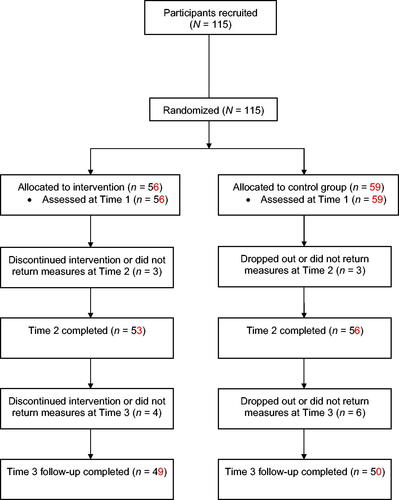Article title: Helping soccer players help themselves: Effectiveness of a psychoeducational book in reducing perfectionism
Authors: Donachie, Tracy C., & Hill, Andrew P.
Journal: Journal of Applied Sport Psychology
Citation details: Volume 34, Number 3, pages 564–584
DOI: https://doi.org/10.1080/10413200.2020.1819472
The authors regret they have made several reporting errors in the paper.
An error was made in reporting the number of participants at each stage of the study. In the original CONSORT diagram (see ; corrections in red), the number of participants was reported as T1 intervention group (n = 55) and control group (n = 60), T2 intervention (n = 52) and control (n = 57) groups, and T3 intervention (n = 48) and control (n = 51) groups. The correct numbers of participants were as follows: T1 intervention group (n = 59) and control group (n = 59), T2 intervention group (n = 53) and control group (n = 56), and T3 intervention group (n = 49) and control group (n = 50). Analyses were based on intention-to-treat (i.e., retaining all dropout participants scores from T1), so the impact of this error is negligible.
An error was also made in the reporting of the effects for group, time, and interaction for 1 of 10 of the variables (self-oriented perfectionism). The original paper reported statistically significant main effects for group and time (p < .05) and a non–statistically significant interaction effect (p > .05) (; corrections in red). However, upon reinspection of the data, there was no statistically significant effect for group but there was a statistically significant main effect for time and interaction effect: group effect, F(1, 113) = 0.00, p = .99, partial η2 = .00, time effect F(1.86, 209.63) = 18.83, p < .001, partial η2 = .14, and interaction effect F(1.86, 209.63) = 16.72, p < .001, partial η2 = .13. Simple effects remain the same for self-oriented perfectionism (; corrections in red).
Table 4. Main group, time, and interaction effects (group × time) (n = 115).
Table 3. Analysis of simple effects on all measures between intervention and control group at each time point (n = 115).
An error was made when examining whether adherence (number of book chapters read, number of exercises complete, hours spent reading the book, and hours spent completing the exercises) was related to changes in the variables. In the original paper, we reported that change in outcome variables were calculated using unstandardized residualized scores corresponding to a regression of T2 (dependent variable) on T1 (predictor variable). However, an error was made in when doing this analysis with the reverse taking place: T2 (predictor variable) on T1 (dependent variable). Once the analysis is done correctly, and using completers from the intervention group only, adherence measures were not statistically correlated with change in outcome variables (p < .05) for which there was an interaction effect. As such, the new findings suggested that higher adherence was not related to larger improvements in the intervention.
The correct Pearson’s correlations between adherence measures and outcome variables are as follows:
Number of chapters read and improvements in self-oriented perfectionism (SOP) r(39) = –.18, p = .287, socially prescribed perfectionism (SPP) r(39) = –.02, p = .916, perfectionistic cognitions (PCI) r(39) = −.10, p = .544, anxiety r(39) = .18, p = .27, anger r(39) = .26, p = .108, dejection r(39) = –.18, p = .287.
+Number of exercises completed and improvements in SOP r(32) = –.05, p = .809, SPP r(32) = .07, p = .699, PCI r(32) = .02, p = .936, anxiety r(32) = –.02, p = .905, anger r(32) = −.10, p = .955, and dejection r(32) = .04, p = .837.
Time spent reading the book and improvements in SOP r(32) = –.13, p = .488, SPP r(32) = .07, p = .724, PCI r(32) = −.11, p = .559, anxiety r(32) = .05, p = .778, anger r(32) = −.26, p = .149, and dejection r(32) = −0.26, p = .148.
Time spent competing exercises and improvements in SOP r(32) = –.06, p = .757, SPP r(32) = –.17, p = .343, PCI r(32) = –.08, p = .661, anxiety r(32) = .09, p = .620, anger r(32) = −.13, p = .467, and dejection r(32) = −.11, p = .540.
In reexamining the data, we took the opportunity to recalculate internal reliabilities (Cronbach’s alpha) for all variables and time points for each group separately (intervention group and control group). All scales displayed acceptable internal reliability α > .70 at all time points for both groups (α = .75 was the lowest, with scores typically >.80).
The authors would like to apologize for any inconvenience caused.
DOI of original article: https://doi.org/10.1080/10413200.2020.1819472
Tracy Donachie, Newcastle University, School of Psychology, 4th Floor, Dame Margaret Barbour Building, Wallace Street, Newcastle upon Tyne, NE2 4DR. [email protected]

